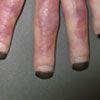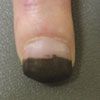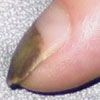Silver Nitrate Staining of Fingernails
Black discoloration appeared on the fingernails of a 51-year-old white man who had sustained burns on 15% of his body in a house fire 2 months earlier. The discoloration is a typical side effect of silver nitrate, which was applied to his skin and fingernails during the month he was hospitalized. This topical broad-spectrum bacteriostatic agent is used to reduce the risk of infection and mortality in burn patients.

Click to Enlarge

Click to Enlarge

Click to Enlarge
Black discoloration appeared on the fingernails of a 51-year-old white man who had sustained burns on 15% of his body in a house fire 2 months earlier. The discoloration is a typical side effect of silver nitrate, which was applied to his skin and fingernails during the month he was hospitalized. This topical broad-spectrum bacteriostatic agent is used to reduce the risk of infection and mortality in burn patients.
The patient was recovering well, although he had scarring in multiple areas, mostly on his upper chest, arms, and hands. No solution can effectively remove the stain from the fingernails. However, normal nail growth will replace the stained areas in about 3 months. As the fingernails grow, the stained areas can be trimmed away.
References:
REFERENCES:
1.
Noronha C, Almeida A. Local burn treatmentÃtopical antimicrobial agents. Annals of Burns and Fire Disasters. December 2000;13:216. Available at:
http://www.medbc.com/annals/review/vol_13/num_4/text/vol13n4p216.htm
. Accessed March 7, 2008.